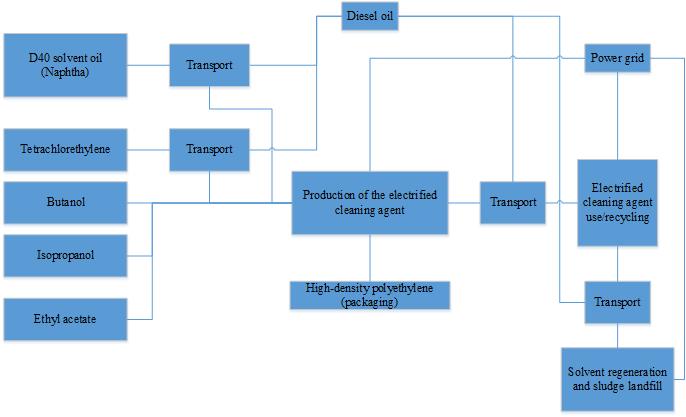
Life Cycle Assessment of A Hydrocarbon-based Electrified Cleaning Agent
Abstract
The electrified cleaning agent requires a moderate volatilization rate, low ozone-depleting substances value, non-flammable, non-explosive and other characteristics. This study performed a whole life cycle assessment on a hydrocarbon-based electrified cleaning agent. The life cycle model is cradle-to-grave, and the background data sets include power grid, transportation, high-density polyethylene, chemicals, etc. The analysis shows that the global warming potential (GWP) of the life cycle of 1 kg of electrified cleaning agent is 2.08 kg CO2 eq, acidification potential (AP) is 9.49E-03 kg SO2 eq, eutrophication potential (EP) is 1.18E-03 kg PO43-eq, respirable inorganic matter (RI) is 2.13E- 03 kg PM2.5 eq, ozone depletion potential (ODP) is 4.91E-05 kg CFC-11 eq, photochemical ozone formation potential (POFP) is 2.89E-02 kg NMVOC eq, ionizing radiation-human health potential (IRP) is 3.16E-02 kg U235 eq, ecotoxicity (ET) is 2.69E-01 CTUe, human toxicity-carcinogenic (HT-cancer) is 4.32E-08 CTUh, and human toxicity-non-carcinogenic (HT-non cancer) is 2.31E-07 CTUh. The uncertainty of the results is between 3.46-9.95%.
The four processes of tetrachloroethylene production, D40 solvent oil production, tetrachloroethylene environmental discharge during product use, and electricity usage during product disposal have substantial effects on each LCA indicator, so they are the focus of process improvement. Changes in power consumption during production and transportation distance of raw materials have little effect on total carbon emissions. Compared with the production process of single-solvent electrified cleaning agent tetrachloroethylene and n-bromopropane, the production of the electrified cleaning agent developed in this study has its own advantages in terms of carbon footprint and other environmental impact indicators. Carbon emissions mainly come from the power consumption of each process, natural gas production and combustion, and other energy materials for heating. It is recommended to use renewable raw materials instead of crude oil to obtain carbon credits based on geographical advantages, and try to use production processes with lower carbon emissions, while the exhaust gas from the traditional production process is strictly absorbed and purified before being discharged.Keywords
Full Text:
FULL TEXT (PDF)References
Rong, X. (2004) Key Performances and Developing Ideas of Cleanser for Electrified Cleaning, Cleaning Technology.
Ecoinvent 3.1. (other countries).Alex Primas.2014-11-13.
CLCD-China-ECER 0.8. Naphtha/Naphtha-Naphtha/Naphtha-Atmospheric Vacuum (China). He Qin.2013-02-09
CLCD-China-ECER 0.8. East China Power Grid-East China Power Transmission (China). HouPing.2013-02-09.
CLCD-China-ECER 0.8. Isopropanol-(China). Fan Cidong. 2013-02-09
CLCD-China-ECER 0.8. Truck transportation-heavy diesel truck transportation (30t)-China (China).yangjie.2013-02-09
CLCD-China-ECER 0.8 data set document. Naphtha/Naphtha-Naphtha/Naphtha-Atmospheric Vacuum (China). He Qin. 2013
Ecoinvent 3.1 data set document. (Other countries). Alex Primas. 2014.
CLCD-China-ECER 0.8 data set document. Isopropanol-(China). Fan Cidong. 2013.
CLCD-China-ECER 0.8 data set document. Truck transportation-heavy diesel truck transportation (30t)-China (China).yangjie.2013.
CLCD-China-ECER 0.8 data set document. East China Power Grid-East China Power Transmission (China). HouPing.2013.
DOI: http://dx.doi.org/10.17737/tre.2021.7.1.00129
Refbacks
- There are currently no refbacks.
Copyright (c) 2021 Peng Liu, Bo Zhang, Changyan Yang, Yu Gong, Yinhang Qu, Jiayi Li, Bohan Yang, Yigang Ding

This work is licensed under a Creative Commons Attribution 4.0 International License.
 This work is licensed under a Creative Commons Attribution 4.0 License.
This work is licensed under a Creative Commons Attribution 4.0 License.Copyright @2014-2025 Trends in Renewable Energy (ISSN: 2376-2136, online ISSN: 2376-2144)
